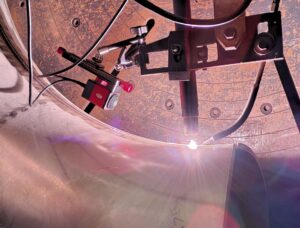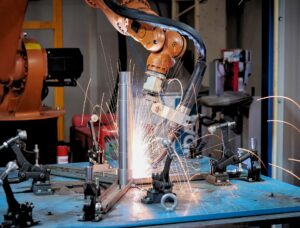In this blog, we’ll explore additive manufacturing welding monitoring and how real-time quality control systems are addressing the unique challenges of layer-by-layer production in 3D printing technologies. Additive manufacturing (AM) has revolutionized production across industries, but the welding processes that build parts layer by layer present unique quality challenges. Real-time monitoring systems specifically designed for AM welding applications are becoming essential for ensuring consistent quality, reducing waste, and enabling the full potential of 3D printing technologies.
The Unique Challenges of Additive Manufacturing Welding
Additive manufacturing welding differs significantly from traditional welding in several critical ways:
Layer Interdependence: Each layer’s quality affects all subsequent layers, meaning early weld defects can propagate throughout the entire build.
Thermal Cycling: Repeated heating and cooling cycles as new layers are added can cause distortion, cracking, and residual stress accumulation.
Build-Up Geometry: Complex three-dimensional geometries create varying thermal conditions and access challenges for monitoring.
Material Considerations: AM often uses specialized powder materials with different melting and flow characteristics than traditional welding consumables.
Process Speed: Many AM processes require rapid layer deposition, demanding monitoring systems that can keep pace with production requirements.
Critical Quality Parameters in Additive Manufacturing Welding
Effective monitoring must track multiple parameters simultaneously:
Layer Adhesion: Proper bonding between layers is essential for structural integrity and mechanical properties.
Thermal History: Complete temperature profiles affect microstructure, residual stress, and dimensional accuracy.
Porosity Control: Gas entrapment and incomplete fusion can create internal defects that compromise part performance.
Dimensional Accuracy: Each layer must be deposited within tight tolerances to achieve final part specifications.
Surface Quality: Layer surface characteristics affect subsequent layer adhesion and final part finish.
Real-Time Monitoring Technologies for Additive Manufacturing Welding
Several advanced technologies enable effective AM welding monitoring:
High-Resolution Thermal Imaging: Infrared cameras that map temperature distribution across the build area with sufficient resolution to detect localized hot spots or cold zones.
Multi-Spectral Imaging: Weld Cameras that capture different wavelengths to reveal information about material composition, oxidation, and thermal conditions.
Laser Interferometry: Precise measurement of layer thickness and surface topology to ensure dimensional accuracy.
Acoustic Monitoring: Detection of process sounds that indicate proper fusion, spatter formation, or other process characteristics.
Melt Pool Monitoring: Welding cameras that directly observe the molten pool during deposition to ensure proper fusion and flow.
Layer-by-Layer Quality Assurance
Real-time monitoring enables unprecedented quality control:
In-Process Correction: Immediate adjustment of process parameters when deviations are detected, preventing defects from propagating to subsequent layers.
Build Termination: Automatic stopping of builds when critical defects are detected, preventing waste of time and materials.
Quality Mapping: Creation of detailed quality maps showing the location and severity of any defects within the build.
Predictive Analysis: AI algorithms that predict where weld defects are likely to occur based on thermal history and process conditions.
Process Control Integration
Modern Additive Manufacturing weld monitoring systems integrate seamlessly with additive manufacturing equipment:
Parameter Feedback: Real-time adjustment of laser power, travel speed, and material feed rates based on monitoring feedback.
Path Optimization: Dynamic adjustment of tool paths to compensate for thermal distortion or material variations.
Support Structure Optimization: Real-time assessment of support structure performance and automatic adjustment when needed.
Multi-Laser Coordination: Coordination of multiple laser systems in large-scale AM equipment to ensure consistent quality across the build area.
Material-Specific Monitoring Requirements
Different Additive Manufacturing materials require tailored monitoring approaches:
Titanium Alloys: Critical monitoring of oxidation and alpha case formation that can affect mechanical properties.
Stainless Steels: Focus on carbide precipitation and sensitization that can reduce corrosion resistance.
Aluminum Alloys: Monitoring of porosity formation and hot cracking susceptibility.
Nickel Superalloys: Thermal monitoring to prevent constitutional liquation and strain-age cracking.
Dissimilar Materials: Special considerations for builds using multiple materials with different thermal properties.
Case Study: Aerospace Component Manufacturing
A leading aerospace manufacturer implemented comprehensive Additive Manufacturing welding monitoring with remarkable results:
Challenge: Traditional post-build inspection missed internal defects that led to expensive part failures during testing and service.
Solution: Integrated monitoring system combining thermal imaging, melt pool observation, and acoustic analysis with AI-powered defect detection.
Results:
- 85% reduction in build failures
- 60% decrease in post-processing time
- 40% improvement in first-pass acceptance rate
- Complete traceability for every layer of every build
Advanced Analytics for Additive Manufacturing Applications
Modern Additive Manufacturing monitoring leverages sophisticated data analysis:
Thermal Modeling: Real-time thermal models that predict temperature distribution and cooling rates throughout the build.
Defect Prediction: Machine learning algorithms that predict defect formation based on process history and current conditions.
Build Optimization: Continuous optimization of process parameters based on real-time weld quality feedback.
Statistical Process Control: SPC analysis of layer-by-layer data to identify process drift and optimization opportunities.
Quality Documentation and Traceability
AM monitoring systems provide comprehensive documentation:
Layer-by-Layer Records: Complete documentation of process parameters and quality metrics for every layer.
Thermal History: Detailed temperature profiles throughout the entire build process.
Defect Location Mapping: Precise identification of any defects and their three-dimensional location within the part.
Process Genealogy: Complete traceability from raw materials through finished part.
Integration with Digital Manufacturing
AM monitoring is becoming integral to digital manufacturing ecosystems:
Digital Twin Integration: Real-time monitoring data feeds into digital twin models that predict part performance and optimize future builds.
Cloud Analytics: Central analysis of data from multiple AM systems to identify best practices and process improvements.
Blockchain Documentation: Immutable quality records that follow parts throughout their lifecycle.
Artificial Intelligence: AI systems that continuously learn and improve quality prediction and process optimization.
Cost-Benefit Analysis
The ROI of AM welding monitoring includes several factors:
Build Success Rate: Improved first-pass success reduces material waste and machine time.
Post-Processing Reduction: Better build quality reduces machining, heat treatment, and finishing requirements.
Inspection Efficiency: Real-time quality assurance reduces or eliminates traditional NDT requirements.
Time-to-Market: Faster qualification of new parts and processes through comprehensive process documentation.
Implementation Best Practices
Successful AM monitoring implementation requires:
Process Understanding: Deep knowledge of AM process physics and common failure modes.
System Integration: Careful integration with existing AM equipment and manufacturing systems.
Operator Training: Comprehensive training on monitoring system operation and quality interpretation.
Continuous Improvement: Regular analysis of monitoring data to optimize detection algorithms and process parameters.
Future Developments
Emerging technologies will further enhance AM welding monitoring:
In-Situ Repair: Systems that can automatically repair defects as they’re detected during the build process.
Multi-Physics Modeling: Integration of thermal, mechanical, and metallurgical models for comprehensive process prediction.
Augmented Reality: AR interfaces that overlay real-time quality data onto the operator’s view of the build process.
Quantum Sensors: Ultra-sensitive sensors that can detect minute variations in material properties and process conditions.
Regulatory Considerations
As AM moves into regulated industries, monitoring becomes critical:
Qualification Requirements: Regulatory bodies increasingly require comprehensive process monitoring for critical applications.
Standard Development: Industry standards for AM monitoring are evolving to ensure consistent quality approaches.
Certification Support: Monitoring data supports part certification and regulatory approval processes.
Future Developments
Emerging technologies in weld pool monitoring include:
Quantum Sensors: Ultra-sensitive sensors for measuring minute variations in pool properties.
AI Integration: Advanced artificial intelligence for real-time decision making and process optimization.
Digital Twin Technology: Virtual models that predict pool behavior and optimize welding parameters.
Augmented Reality: Real-time overlay of monitoring data onto the operator’s view of the welding process.
Conclusion
Real-time monitoring of additive manufacturing welding processes represents a fundamental shift from traditional quality control approaches. The ability to observe and control quality layer by layer enables unprecedented levels of part integrity and process optimization.
As AM technology continues to mature and move into production applications, comprehensive monitoring will become standard practice. Companies that invest in these capabilities today will be positioned for success in the rapidly growing additive manufacturing market, with the ability to produce high-quality parts efficiently and cost-effectively.
The future of AM lies not just in advanced hardware and materials, but in the intelligent monitoring and control systems that ensure every layer meets the highest quality standards.
Looking to improve your welding workflow? Mecaweld offers advanced welding camera systems that help you visualize, inspect, and refine every weld. Contact us to learn how we can help you take control of weld quality in stainless steel projects.



